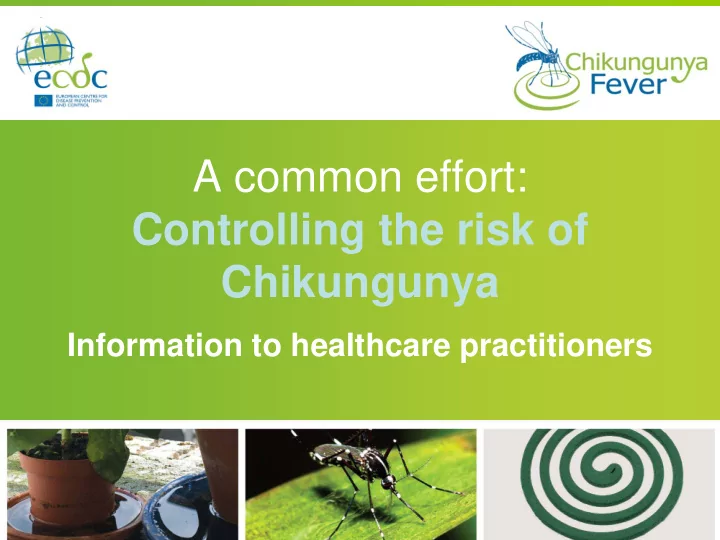

A common effort: Controlling the risk of Chikungunya Information to healthcare practitioners 1
Contents • What is Chikungunya? • Symptoms • Transmission • Epidemiology • Preventive measures for personal protection • What to do in the event of a possible case of Chikungunya • Community measures for vector control • Links/contacts for more information 2
What is Chikungunya? • Chikungunya is a virus that is transmitted from human to human mainly by infected Aedes albopictus and Aedes aegypti mosquitoes (later referred to as Aedes mosquitoes ) acting as the disease- carrying vector • Chikungunya causes sudden onset of high fever, severe joint pain, muscle pain and headache • As no vaccine or medication is currently available to prevent or cure the infection, control of Chikungunya involves vector control measures and encouraging people to avoid mosquito bites 3
Symptoms • Symptoms include: � Sudden onset of high fever � Headache � Back pain � Myalgia � Arthralgia • The symptoms will appear on average 4 to 7 days (but can range from 1 to 12 days) after being bitten by an infected Aedes mosquito 4
Transmission The Vector • Chikungunya virus is spread among humans mainly by the bites of infected Aedes mosquitoes acting as the disease-carrying vector • These mosquito types are characterised by white stripes on their black bodies and legs • The next slide shows a map of areas where mosquitoes infected with Chikungunya virus are present Aedes albopictus 5
Epidemiology Chikungunya risk zones Outbreaks of Chikungunya virus are usually found in: – Africa – Southeast Asia – Indian subcontinent and islands in the Indian Ocean 6
Epidemiology Presence of Aedes mosquitoes The increasing presence of Aedes mosquitoes in Southern continental Europe has made outbreaks of Chikungunya a new health risk in these regions It is therefore important to provide information on how to limit the risk of mosquito bites to people living in or visiting affected areas 7
Preventive measures Seeking protection from Chikungunya When staying in affected areas: • Wear long-sleeved shirts and long trousers • Use mosquito repellents, coils or other devices that will help fend off mosquitoes • If possible, sleep under bed nets pre-treated with insecticides • If possible, set the air-conditioning to a low temperature at night – mosquitoes do not like cold temperatures • Pregnant women, children under 12 years old, and people with immune disorders or severe chronic illnesses should be given personalised advice 8
What should I do if I suspect my patient has Chikungunya? ECDC proposes the following case definitions for Chikungunya: Clinical criteria: acute onset of fever (>38.5°C) and severe/incapacitating arthralgia not explained by other medical conditions Epidemiological criteria: residing or having visited epidemic areas, having reported transmission within 15 days prior to the onset of symptoms Laboratory criteria: at least one of the following tests in the acute phase: • Virus isolation • Presence of viral RNA by RT-PCR • Presence of virus specific IgM/IgG antibodies in single serum sample collected • Seroconversion to virus-specific antibodies in samples collected at least one to three weeks apart 9
What should I do if I suspect my patient has Chikungunya? Chikungunya may be a reportable disease. ECDC proposes the following reporting levels: Case categories • Possible case: a patient meeting clinical criteria • Probable case: a patient meeting both the clinical and epidemiological criteria • Confirmed case: a patient meeting the laboratory criteria, irrespective of the clinical presentation 10
Algorithm for ascertainment of suspected Chikungunya case Source : ECDC Mission Report: Chikungunya in Italy, Joint ECDC/WHO visit for a European risk assessment 17 – 21 September 2007 11
What should I do if I suspect my patient has Chikungunya? Treatment • In the absence of treatment for Chikungunya fever, focus is set on: – symptomatic treatment only (non-steroid anti-inflammatories, non- salicylic analgesics) – surveillance of the patient for complications – prevention of further transmission • In order to prevent further transmission, infected persons should avoid further mosquito bites (e.g. use of repellents or sleeping under bed nets as much as possible) Complications • Possible complications include gastro-intestinal complications, cardiovascular decompensation or meningo-ecephalitis • Fatalities have been reported mainly in aged patients or where the patient’s immune system was weakened by underlying conditions 12
Community measures For healthcare practitioners in areas where the vector is present 13
Vector control It is important to provide information on how to reduce the spread of the vector to people living in affected areas 14
Community measures Reducing the spread of the vector • The vector lives in a number of different habitats • The presence of water is of great importance for mosquitoes’ breeding as their eggs require water in order to develop into adult mosquitoes 15
Community measures Reducing the spread the vector It is important that every citizen takes action to avoid water gathering in containers in the vicinity of their home 16
Links/contacts For more information on Chikungunya, please consult the ECDC website: http://ecdc.europa.eu/Health_topics/Chikungunya_Fever/Chikungunya _Fever.html 17
Recommend
More recommend